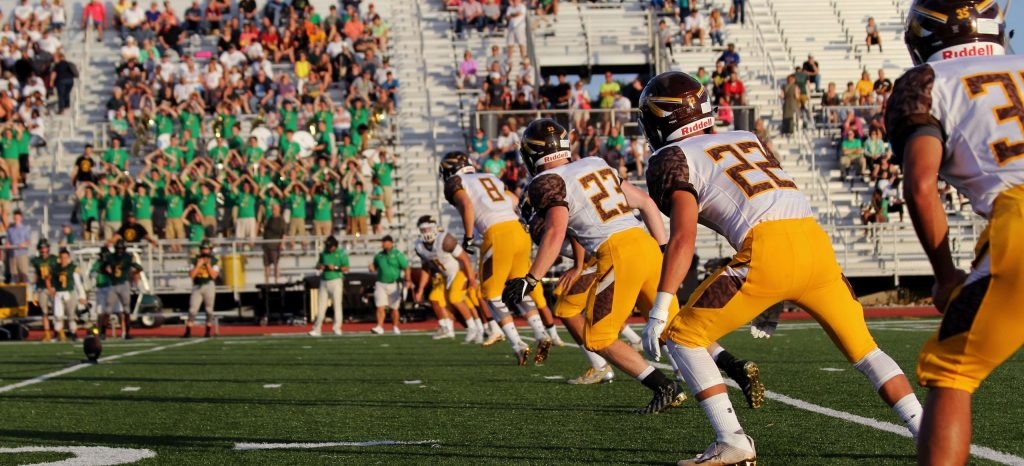Student-centric advice and objective recommendations
Higher education has never been more confusing or expensive. Our goal is to help you navigate the very big decisions related to higher ed with objective information and expert advice. Each piece of content on the site is original, based on extensive research, and reviewed by multiple editors, including a subject matter expert. This ensures that all of our content is up-to-date, useful, accurate, and thorough.
Our reviews and recommendations are based on extensive research, testing, and feedback. We may receive commission from links on our website, but that doesn’t affect our editors’ opinions. Our marketing partners don’t review, approve or endorse our editorial content. It’s accurate to the best of our knowledge when posted. You can find a complete list of our partners here.
What Does Being a D1, D2, and D3 Athlete Mean?
 By
Gabriel Jimenez-Ekman
By
Gabriel Jimenez-Ekman 
Gabriel Jimenez-Ekman is a content editor and writer at Scholarships360. He has managed communications and written content for a diverse array of organizations, including a farmer’s market, a concert venue, a student farm, an environmental NGO, and a PR agency. Gabriel graduated from Kenyon College with a degree in sociology.
Full BioLearn about our editorial policies

Maria Geiger is Director of Content at Scholarships360. She is a former online educational technology instructor and adjunct writing instructor. In addition to education reform, Maria’s interests include viewpoint diversity, blended/flipped learning, digital communication, and integrating media/web tools into the curriculum to better facilitate student engagement. Maria earned both a B.A. and an M.A. in English Literature from Monmouth University, an M. Ed. in Education from Monmouth University, and a Virtual Online Teaching Certificate (VOLT) from the University of Pennsylvania.
Full BioLearn about our editorial policies

If you’re a high school athlete, you may be looking into continuing your athletic career in college. As it comes time to shop around between schools and look at their athletic programs, you’ll see that most schools offer either D1, D2, or D3 athletics. But what do these categories mean, and how will they impact your time playing for the college? In this article, we’ll explain everything about what a D1, D2, or D3 athlete is, and how your division impacts your college and athletic experience.
Related: Top athletic scholarships for students
What do D1, D2, and D3 mean?
D1, D2, and D3 stand for Divisions 1, 2, and 3, which are athletics leagues run by the National Collegiate Athletic Association, or NCAA. These are the leagues that most colleges in the United States compete in. If a team is not competing in the NCAA, it is typically a team that plays inter or intramural friendly matches.
@scholarships360 If you are thinking of becoming a college athlete, ask yourself these six questions and then check out the full article 👇 https://scholarships360.org/college-admissions/what-is-a-d1-athlete/ #scholarships360 #scholarships #d1 #collegeathlete #studentathlete #collegeadvice
♬ original sound – scholarships360
Differences between D1, D2, and D3
Essentially, all of the differences between D1, D2, and D3 are in terms of intensity and competitiveness. D1 is the most competitive and intense, while D3 is the least. D1 athletes’ college experience will be defined by their athletics. Meanwhile, D3 athletes will probably spend less of their time playing and practicing, though it is still a big commitment. Let’s get into how this change in intensity affects each aspect of your college experience.
Financial aid
D1
Although this is not always the case, it is quite common for D1 athletes to get full-ride scholarships. This means that they will not have to pay for any of their college expenses. This includes tuition, room and board, fees, books, and everything else you could imagine. They might even receive a college stipend. If they don’t get a full-ride, they typically at least get substantial financial aid.
D2
D2 athletes typically get some scholarships, but not nearly as much as D1 athletes. Full-ride scholarships are much less common. However, you can still use your athletic ability to help pay for college as a D2 athlete.
D3
D3 athletes do not get scholarships directly for their athleticism. Although they might receive money from the school as a result of their athletic accomplishments, it carries a different dynamic than D1 and D2 financial aid. This is because schools cannot give direct athletic scholarships to D3 athletes. You might earn a financial aid package that reflects your athletic accomplishments, but it will not be tied directly to your athletic career.
Key difference between D3 and D1 & D2
The key difference here is that if a D3 athlete decides to quit the team, they will still receive their financial aid money. So, although the sum will be significantly less than they could expect for D1 or D2 athletics, it does not hinge on their participation in a sport. For athletes who are unsure whether they want to continue playing through school, D3 could be a great option. You don’t want to end up in a spot where you are unable to quit because your financial aid relies on it.
Related: What you need to know about the Big 10 Schools
Recruiting
Recruiting systems vary based on each system. D1 athletics usually start recruiting as early as sophomore year. On the other hand, D2 athletics usually begin recruiting in junior year, and sometimes continue into senior year. D3 athletics usually only begin recruiting during senior year. This may vary by school, and some schools have more intensive recruiting resources than others.
It may be that some D2 or D3 students begin recruiting local talent as early as sophomore or early junior year. Oftentimes, colleges try to prioritize recruiting talent in their region. So, you might find a few D2 or D3 schools scouting games earlier on in your high school years.
Related: What is NCSA Athletic Recruiting?
Athletic budget
As you might expect, athletic budgets vary based on the intensity of the program. D1 schools have by far the highest budgets, and they typically decrease for D2 schools and even more for D3 schools. But what does that change in budget mean? Here are a few factors that will change based on your school’s budget:
- Stadium size and quality
- Prestige and experience of your coach
- Training equipment quality and availability
- Resources for travel
- Coaching staff and physical therapist availability
Apply to these scholarships due soon
See more athletic scholarshipsLikelihood of landing a spot on the team
D1 athletics are by far the hardest sport to land a spot on. According to data from the NCAA, in 2020, 7.3% of varsity high school football players went on to play college sports, and only 2.9% of those went on to play D1. About 3% of wrestlers went on to compete in college, and 1% went on to compete in D1. So, we see that typically about one third of the students who continue competing in college make D1.
In this study through the NCAA, each division took about a third of the students who went on to compete in college. This means that if you are in that slim percentage of people going on to compete in college, you’ll also have to be in the top 33 percentile to compete in D1, middle 33 percentile for D2, or bottom for D3. But remember – even if you qualify to compete in D1 or D2, you could choose to compete in D3 if you don’t want to commit so heavily to your sport.
Related: Communications major overview
Commitment
D1
Your schedule will be based almost entirely around your athletics. This means that you’ll be training intensively throughout the whole year, and you might even need to take summer school to ensure you’re meeting academic requirements. You’ll travel a lot and constantly prioritize athletics over other responsibilities. During the off-season, you’ll spend most of your time training or making up your academic requirements.
D2
This can vary greatly based on your school and the conference in which you compete. You might have summers off, and you might not have to train as much during the off-season. You also typically won’t travel as much, as your conference will be more regional. However, you’ll still prioritize your athletics over most other responsibilities. It’s difficult to maintain any other substantial extracurriculars as a D2 athlete.
D3
D3 students have by far the most freedom of the three divisions. You’ll be traveling much shorter distances, have a less intensive off-season, and you’ll have summers off. This can help you develop skills for a future career or pursue other interests while playing varsity athletics. It is still a big commitment and will cut into your free time significantly. However, it is a huge step down from D1 and D2 in terms of its requirements.
Related: What Schools Make Up the SEC?
Competition
You’ll face very competent opponents in any NCAA college athletic league. However, you’ll face by far the most talented competition in D1. The vast majority of players who have some intention of going pro end up in D1 athletics, so odds are, you’ll be playing against at least a few future pros. This is less common in D2, and almost never occurs in D3. However, anyone who secures a spot in these leagues is an accomplished athlete who will be exciting to play alongside or against.
Post-college athletic potential
If you are looking to go pro after college, D1 is definitely your best bet. But you should note that the numbers are daunting for going professional. For example, only 1.6% of college football players land a spot in the NFL. That takes into account D1, D2, and D3, so the numbers are definitely higher for D1 players. But despite D1’s intense competitiveness, it is still far from a sure bet to go professional. A select few D2 athletes also end up going pro, but D3 athletes almost never go pro.
Related: Top sports-related careers
How to choose
When it comes time to choose a division, most players will choose the highest division that accepts them. For many, this is the right choice. Athletes are passionate about their sport, and oftentimes want to pursue it as far as they can. Especially if you intend to go pro, you should absolutely go with any D1 school that admits you. But if you are not interested in going pro, you might face a more difficult choice. If you gain admission to a D2 and a D3 school, it might be tough to decide which to choose. In this case, it’s a good idea to decide how big a role you want sports to play in your college life. Here are some questions to ask yourself:
- Do I want to pursue my sport as far as I can possibly pursue it?
- Am I interested in pursuing other extracurriculars in college?
- Does it sound appealing to spend a significant amount of time traveling in school?
- How much time do I want to devote to academics?
- Do I want to commit to playing my sport for four years, or keep the option to quit and maintain my financial aid?
- Is better equipment and coaching staff a big factor for me?
In asking yourself these questions, you’ll be able to make an informed decision about the league that’s right for you. Good luck out on the field, champ!
Related: How to choose a college













 SAT" printed on his pencil">
SAT" printed on his pencil">
